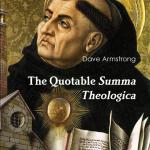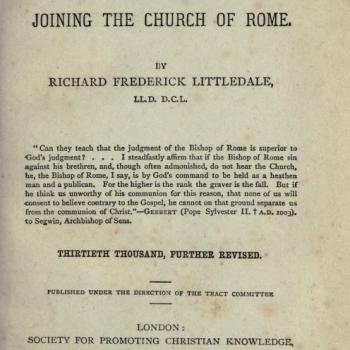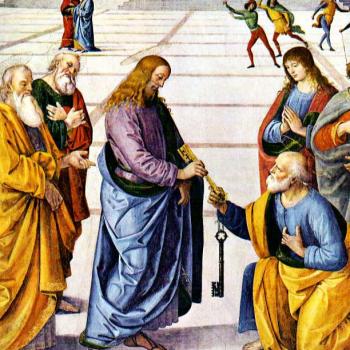Includes Documentation of 14 Church Fathers Who Thought Peter Was the Rock
“Please Hit ‘Subscribe’”! If you have received benefit from this or any of my other 4,600+ articles, please follow this blog by signing up (with your email address) on the sidebar to the right (you may have to scroll down a bit), above where there is an icon bar, “Sign Me Up!”: to receive notice when I post a new blog article. This is the equivalent of subscribing to a YouTube channel. Please also consider following me on Twitter / X and purchasing one or more of my 55 books. All of this helps me get more exposure, and (however little!) more income for my full-time apologetics work. Thanks so much and happy reading!
***
Matthew 16:13-19 (RSV) Now when Jesus came into the district of Caesare’a Philip’pi, he asked his disciples, “Who do men say that the Son of man is?” [14] And they said, “Some say John the Baptist, others say Eli’jah, and others Jeremiah or one of the prophets.” [15] He said to them, “But who do you say that I am?” [16] Simon Peter replied, “You are the Christ, the Son of the living God.” [17] And Jesus answered him, “Blessed are you, Simon Bar-Jona! For flesh and blood has not revealed this to you, but my Father who is in heaven. [18] And I tell you, you are Peter, and on this rock I will build my church, and the powers of death shall not prevail against it. [19] I will give you the keys of the kingdom of heaven, and whatever you bind on earth shall be bound in heaven, and whatever you loose on earth shall be loosed in heaven.”
In an old article of his, dated c. 2000, Baptist anti-Catholic apologist James White stated (his words in blue below):
. . . the unique, and sometimes very strained, exegetical claims of Rome . . .
. . . the Roman Catholic identification of Peter as the rock of Matthew 16:18 . . .
. . . when one reads the text as it stands (i.e., when one does not immediately abandon the Greek and run to a mythical, unverifiable “Aramaic original”), one is struck with how strange it is that Jesus takes the “long way around” to get to making the equation “Peter = rock” if in fact that is His intention. It would have been much simpler to say, “You are Peter, and on you I will build My church.” But He didn’t say that. . . .
As we simply translate the passage and attempt to ascertain the meaning, we note that Jesus begins with direct personal address to Peter. “And I say to you (soi)” is singular, addressed to Peter and to Peter alone. This is continued in the first part of the main statement, “You (su,) are (singular) Peter.” This is known as direct address. Jesus is speaking in the first person, and Peter is in the second person, being directly addressed by the Lord. Up to this point, all is clear and understandable. . . .
Rome insists the referent is Peter. But if it is, why use a demonstrative pronoun at all? Jesus has used two personal pronouns of Peter already in this sentence, soi and su,. He could have easily said, “and upon you the rock,” . . . But again, He didn’t. Instead, he switches from direct address to the demonstrative “this.” I have expressed this, in non-technical language, as going from second person, “you, Peter,” to third person, “this rock.” “This rock” is referring to something other than the person who was being addressed in the preceding phrase, something that we find in the immediate context. A natural reading of the passage (one that I truly believe would be nigh unto universal if history had not fallen out as it did, with only one “apostolic see” in the West, the continuance of the Empire in the East, etc.) makes it plain what must function as the antecedent of the demonstrative pronoun:
15 He said to them, “But who do you say that I am?” 16 Simon Peter answered, “You are the Christ, the Son of the living God.” 17 And Jesus said to him, “Blessed are you, Simon Barjona, because flesh and blood did not reveal this to you, but My Father who is in heaven.
The confession that Peter gives of the Messiahship of Jesus is the central thought of the entire passage. It is the reason for the trip to Caesarea Philippi. Jesus indicates that Peter has just been the recipient of divine revelation. God, in His grace, has given to Peter an insight that does not find its origin in the will of man, but in God the Father Himself. The content of that confession is, in fact, divine revelation, immediately impressed upon the soul of Peter. This is the immediate context of verse 18, and to divorce verse 18 from what came before leads to the errant shift of attention from the identity of Christ to the identity of Peter that is found in Roman Catholic exegesis. Certainly we cannot accept the idea, presented in Roman theology, that immediately upon pronouncing the benediction upon Peter’s confession of faith, the focus shifts away from that confession and what it reveals to Peter himself and some office with successors based upon him! Not only does the preceding context argue against this, but the following context likewise picks up seemlessly with what came before: the identity of Jesus as Messiah. Hence, the logical antecedent for tau,th| is Peter’s confession. Such not only commands the most logical grammatical sense, but it also commands the obvious teaching of the rest of the New Testament itself! While Peter falls out of view by Acts 15, the centrality of the Messiahship of Jesus continues in the forefront throughout the recorded history of the primitive Church.
Hence I have suggested that the shift from the direct address of Peter to the use of the demonstrative pronoun, pointing us back to something prior, specifically, the confession of faith, that will function as the foundation of the Church Christ promises to build, is significant and must be explained by the Roman apologist who seeks to present an interpretation that is to be binding upon all Christians.
White cites the excommunicated Catholic heretic Joseph von Döllinger (who denied papal infallibility in 1870 and formed the schismatic Old Catholics), and his work The Pope and the Council (Boston: Roberts, 1869, p. 74), arguing that
Not one of [the Church fathers who dealt with Matthew 16 at all] has explained the rock or foundation on which Christ would build His Church of the office given to Peter to be transmitted to his successors, but they understood by it either Christ Himself, or Peter’s confession of faith in Christ; often both together. Or else they thought Peter was the foundation equally with all the other Apostles, the twelve being together the foundation-stones of the church.
It’s odd for a scholar of Döllinger’s acumen to be so ignorant of Church and patristic history. Here are fourteen explicit examples of Church fathers calling Peter the Rock (one could also say that he was the rock based on his confession of faith; but nevertheless, he was the rock upon which the Church was established; that both things were true; also that Jesus was the rock, too, but in a different sense):
Tertullian, writing around 200-220, stated that “Peter . . . is called the Rock whereon the Church was to be built” (Prescription against Heretics, 22).
Origen writing around 230-250, called Peter “that great foundation of the Church, and most solid rock, upon which Christ founded the Church” (In Exod. Hom. v. n. 4, tom. ii) and “Upon him (Peter) . . . the Church was founded” (In Epist. ad Rom. lib. v. c. 10, tom. iv) and “Peter upon whom is built Christ’s Church” (T. iv. In Joan. Tom. v.).
St. Cyprian, c. 246, wrote about “Peter, upon whom by the same Lord the Church had been built” (Epistle 54 to Cornelius, 7).
Firmilian, c. 254, wrote about “one Church, which was once first established by Christ on a Rock” (Inter Ep. S. Cyp. Ep. lxxv).
Aphraates (c. 336) stated that “the Lord . . . set him up as the foundation, called him the rock and structure of the Church” (Homily 7:15, De Paenitentibus).
St. Ephraem (c. 350-370) called Peter “the foundation of the holy Church” (Homilies 4:1).
St. Hilary of Poitiers in 360 held that Peter was “the foundation-stone of the Church” (On the Trinity, Bk. VI, 20).
St. Gregory of Nazianzen (370) stated that Peter “is entrusted with the Foundations of the Church” (T. i. or. xxxii. n. 18).
St. Gregory of Nyssa (371) wrote that Peter was “the Head of the Apostles . . . (upon him) is the Church of God firmly established. . . . that unbroken and most firm Rock upon which the Lord built His Church” (Alt. Or. De S. Steph.).
St. Basil the Great (371) stated that Peter “received on himself the building of the Church” (Adversus Eunomius 2:4).
St. Epiphanius (c. 385): “upon which (Rock) the Church is in every way built . . . Foundation of the house of God” (Adv. Haeres.).
St. Ambrose (c. 385-389): “whom when He styles a Rock, He pointed out the Foundation of the Church” (T. ii. l. iv. De Fide, c. v. n. 56).
St. John Chrysostom (c. 387): “Head or Crown of the Apostles, the First in the Church . . . that unbroken Rock, that firm Foundation, the Great Apostle, the First of the disciples” (T. ii. Hom. iii. de Paenit. n. 4).
St. Jerome (385): “Peter, upon whom the Lord has founded the Church” (Letters 41, 2).
Why is it invalid to point out the insertion of a demonstrative pronoun when the personal pronouns already used in the prior portion of the sentence would have made things so much clearer, if in fact Jesus was just continuing on in referring to Peter himself? . . . You have no demonstrative pronoun, you have no direct address in one clause, followed by an interruption using a demonstrative in the second. You have no question as to what the antecedent of the demonstrative is.
Reading White’s polemics, one would get the impression that no one except Catholics ever thought the Rock in Matthew 16 was Peter himself. And if they did, they were exegetical and linguistic / grammatical troglodytes, idiots, and imbeciles. Can White really be this ignorant? I have found no less than thirty prominent Protestant exegetes and reference works who also held that Peter himself (not his confession) was the Rock:
New Bible Dictionary, Word Studies in the New Testament (Marvin Vincent), Wycliffe Bible Commentary, New Bible Commentary, Anchor Bible (William F. Albright and C. S. Mann), Tyndale New Testament Commentaries (R. T. France), Expositor’s Bible Commentary (D. A. Carson), Eerdmans Bible Commentary, Henry Alford, Herman N. Ridderbos, Albert Barnes, David Hill, M. Eugene Boring, William Hendriksen, John A. Broadus, Carl Friedrich Keil, Gerhard Kittel, Oscar Cullmann, Peake’s Commentary, Gerhard Maier, J. Knox Chamblin, Craig L. Blomberg, William E. McCumber, Donald A. Hagner, Philip Schaff, Lange’s Commentary on the Holy Scriptures: The Gospel According to Matthew, vol. 8, The Layman’s Bible Commentary, Encyclopaedia Britannica (1985; article by D. W. O’Connor, a Protestant), Robert McAfee Brown, and Richard Baumann. Some highlights:
R. T. France, one of the most respected Protestant exegetes of our time, wrote:
Jesus now sums up Peter’s significance in a name, Peter . . .It describes not so much Peter’s character (he did not prove to be ‘rock-like’ in terms of stability or reliability), but his function, as the foundation-stone of Jesus’ church. The feminine word for ‘rock’, ‘petra’, is necessarily changed to the masculine ‘petros’ (stone) to give a man’s name, but the word-play is unmistakable (and in Aramaic would be even more so, as the same form ‘kepha’ would occur in both places). It is only Protestant overreaction to the Roman Catholic claim . . . that what is here said of Peter applies also to the later bishops of Rome, that has led some to claim that the ‘rock’ here is not Peter at all but the faith which he has just confessed. The word-play, and the whole structure of the passage, demands that this verse is every bit as much Jesus’ declaration about Peter as v.16 was Peter’s declaration about Jesus . . . It is to Peter, not to his confession, that the rock metaphor is applied . . .
Peter is to be the foundation-stone of Jesus’ new community . . . which will last forever. (in Leon Morris, General Editor, Tyndale New Testament Commentaries, Leicester, England: Inter-Varsity Press/Grand Rapids, Michigan: Eerdmans Pub. Co., 1985, vol. 1: Matthew, 254, 256)
D. A. Carson, another highly regarded Protestant exegete, observed:
On the basis of the distinction between ‘petros’ . . . and ‘petra’ . . . , many have attempted to avoid identifying Peter as the rock on which Jesus builds his church. Peter is a mere ‘stone,’ it is alleged; but Jesus himself is the ‘rock’ . . . Others adopt some other distinction . . . Yet if it were not for Protestant reactions against extremes of Roman Catholic interpretation, it is doubtful whether many would have taken ‘rock’ to be anything or anyone other than Peter . . .
The Greek makes the distinction between ‘petros’ and ‘petra’ simply because it is trying to preserve the pun, and in Greek the feminine ‘petra’ could not very well serve as a masculine name . . .
Had Matthew wanted to say no more than that Peter was a stone in contrast with Jesus the Rock, the more common word would have been ‘lithos’ )`stone’ of almost any size). Then there would have been no pun – and that is just the point! . . .
In this passage Jesus is the builder of the church and it would be a strange mixture of metaphors that also sees him within the same clauses as its foundation . . . (in Frank E. Gaebelein, General Editor, Expositor’s Bible Commentary, Grand Rapids, Michigan: Zondervan, 1984, vol. 8: Matthew, Mark, Luke [Matthew: D. A. Carson], 368)
New Bible Dictionary states that “Mt 16:19 is in the singular, and must be addressed directly to Peter . . . Many Protestant interpreters, including notably Cullmann, take the latter view” (J. D. Douglas, editor, Grand Rapids, Michigan: Eerdmans, 1962, 972).
Marvin Vincent’s Word Studies in the New Testament (surely better acquainted with NT Greek than James White), observed:
The word refers neither to Christ as a rock, distinguished from Simon, a stone, nor to Peter’s confession, but to Peter himself, . . . The reference of `petra’ to Christ is forced and unnatural. The obvious reference of the word is to Peter. The emphatic this naturally refers to the nearest antecedent; and besides, the metaphor is thus weakened, since Christ appears here, not as the foundation, but as the architect: `On this rock will I build.’ Again, Christ is the great foundation, the `chief cornerstone,’ but the New Testament writers recognize no impropriety in applying to the members of Christ’s church certain terms which are applied to him. For instance, Peter himself (1 Pet 2:4), calls Christ a living stone, and in ver. 5, addresses the church as living stones . . .
Equally untenable is the explanation which refers ‘petra’ to Simon’s confession. Both the play upon the words and the natural reading of the passage are against it, and besides, it does not conform to the fact, since the church is built, not on confessions, but on confessors – living men . . . (Grand Rapids, Michigan: Eerdmans, 1946 [orig. 1887], four volumes; vol. 1: 91-92)
Encyclopaedia Britannica (“Peter,” 1985) noted that “the consensus of the great majority of scholars today is that the most obvious and traditional understanding should be construed, namely, that rock refers to the person of Peter.” D. W. O’Connor, the author of the article, is himself Protestant and author of Peter in Rome: The Literary, Liturqical & Archaeological Evidence (1969).
Anchor Bible (William F. Albright and C. S. Mann) concurs: “In view of the background of verse 19 . . . one must dismiss as confessional interpretation [i.e., biased by denominational views] any attempt to see this rock as meaning the faith, or the Messianic confession of Peter . . . The general sense of the passage is indisputable . . .” (Garden City, New York: Doubleday, 1971, vol. 26, 195, 197-198).
*
***
*
Practical Matters: Perhaps some of my 4,600+ free online articles (the most comprehensive “one-stop” Catholic apologetics site) or fifty-five books have helped you (by God’s grace) to decide to become Catholic or to return to the Church, or better understand some doctrines and why we believe them.
Or you may believe my work is worthy to support for the purpose of apologetics and evangelism in general. If so, please seriously consider a much-needed financial contribution. I’m always in need of more funds: especially monthly support. “The laborer is worthy of his wages” (1 Tim 5:18, NKJV). 1 December 2021 was my 20th anniversary as a full-time Catholic apologist, and February 2022 marked the 25th anniversary of my blog.
PayPal donations are the easiest: just send to my email address: apologistdave@gmail.com. Here’s also a second page to get to PayPal. You’ll see the term “Catholic Used Book Service”, which is my old side-business. To learn about the different methods of contributing (including Zelle), see my page: About Catholic Apologist Dave Armstrong / Donation Information. Thanks a million from the bottom of my heart!
*
***
Photo credit: Photo of yours truly in Israel in 2014, in front of the rock in Caesarea Philippi where Jesus renamed Peter “Rock”: from my book, Footsteps That Echo Forever.
Summary: Baptist anti-Catholic James White vainly argues that the interpretation of Peter himself being the Rock in Matthew 16 is solely a Catholic (and non-patristic) thing.


















